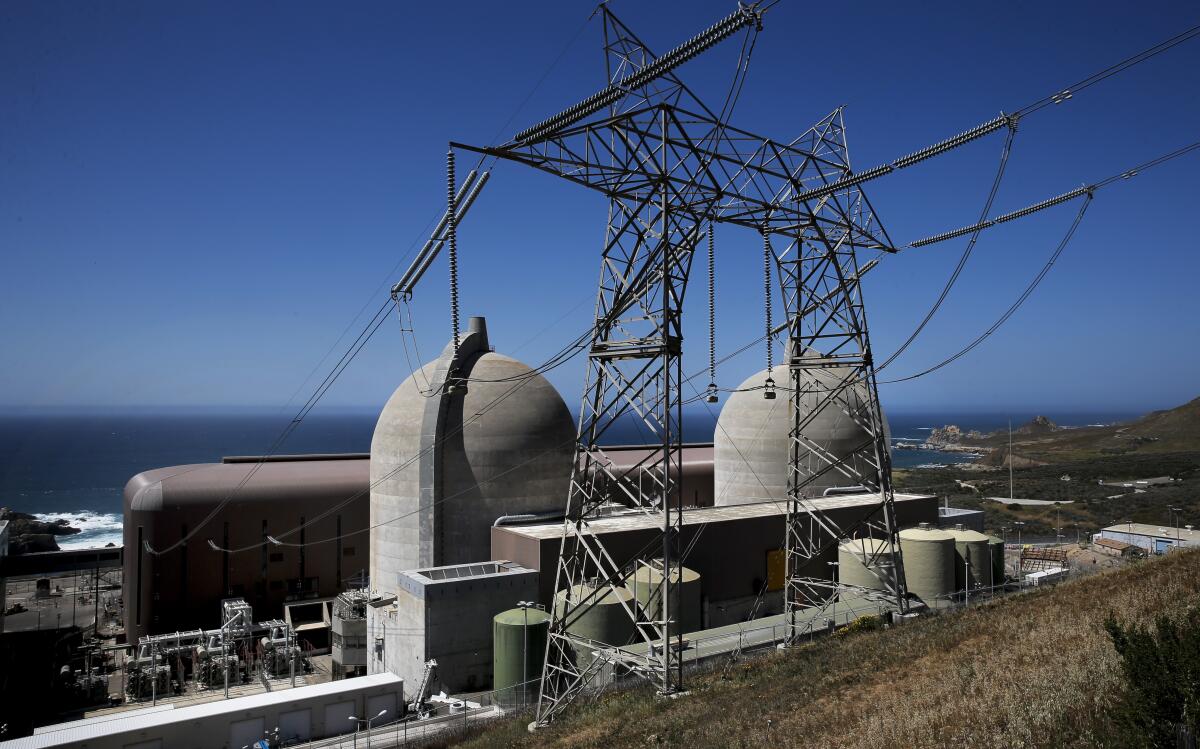We don’t need Diablo Canyon’s nuclear power to prevent summer blackouts

- Share via
An eleventh-hour attempt is underway in the California Legislature to extend the Diablo Canyon nuclear power plant’s operations past its 2025 retirement deadline. The reasons proponents offer for this about-face are to preserve the reliability of the state’s electric grid during peak summer power use and to maintain a carbon-free source of power while more clean energy sources come online.
Reliable electricity service is a public health and environmental imperative; so is using carbon-free power to address the accelerating climate crisis. But extending the life of Diablo Canyon is not prudent or necessary to achieve either goal. This was true in 2016, when Pacific Gas and Electric, the operator of Diablo Canyon, and many others reached an agreement — which the state approved — to retire it in 2025, at the termination of its federal license. Then, as now, replacing the plant with zero carbon resources was an urgent priority and a centerpiece of the agreement.
In terms of grid reliability, Diablo Canyon generates only a small percentage of what is needed to cover the state’s needs during those peak summer hours. A recent assessment by the California Energy Commission suggested that meeting peak summer usage in 2025 would require more than 60,000 megawatts of electricity (around double that for a typical spring day). Diablo Canyon provides only about 2,200 megawatts, less than 4% of that total. Moreover, Diablo Canyon lacks the flexible operating characteristics that are needed to meet temporary summertime demand surges. It is designed to run year-round, 24/7.
During California’s electricity crisis of 2000-01, the state dealt with the shortage by helping customers reduce demand, cutting peak electricity use by more than 12% (4,800 megawatts, or more than two Diablo Canyons) in just a few months. This approach included improvements in air conditioning, other appliances and lighting systems, along with incentives to shift electricity use away from peak periods. These measures, of course, had long-lasting benefits well beyond addressing the immediate shortage.
Efforts to increase energy efficiency — and thus reduce electricity needs — are the cleanest and cheapest ways to move toward rapid carbon reduction and are the state’s top energy priority by law. For example, lightbulbs and refrigerators today use less than one-fourth as much electricity as their predecessors while providing better service. Efficiency standards have cut energy needs of new California homes and commercial buildings by more than half while improving occupants’ comfort.
More aggressive incentives to expand wind power and solar and battery storage are critical to decarbonizing the future while meeting electrification needs. Since 2007, the United States has cut total carbon pollution from electricity generation by a third, with most of that improvement due to wind, solar and energy efficiency gains (nuclear generation has barely changed). Worldwide, additions of wind and solar generating capacity in 2020 (238,000 megawatts) were more than 500 times greater than nuclear power additions (400 megawatts).
Better coordination of the unnecessarily fragmented western power grid would help too, and would bring large cost savings.
Extending the operation of Diablo Canyon has not previously figured in California’s plans to develop a carbon-free economy. All five of the state’s largest utilities have recently released blueprints for eliminating carbon pollution. Not one recommends or even mentions renewal of Diablo Canyon’s operating license. And PG&E released one of the most ambitious plans in June — without proposing additional years for Diablo Canyon.
The proponents of the new Diablo Canyon legislation are well aware of the environmental and financial costs of keeping the plant operating for 10 more years. Since the 1960s-era plant isn’t designed to meet modern environmental regulations, the proposal would give it sweeping exemptions from the California Environmental Quality Act, the California Coastal Act and the state’s water cooling requirements, which limit the discharge of massive quantities of heated water into the sea.
The state would also loan PG&E up to $1.4 billion to cover costs of extending Diablo Canyon’s operating life, with all of the loan potentially “forgivable.” In addition, every customer of a local community choice aggregator or a California investor-owned utility (including Southern California Edison and San Diego Gas & Electric) would share responsibility for paying $760 million per year in operating and replacement power costs for Diablo Canyon, which previously recovered all its costs from PG&E customers. In other words, most Californians who don’t get any service from PG&E would see their electricity bills increase to pay the utility to continue running the plant.
Late August in Sacramento is notorious for ill-considered proposals that could never survive rigorous analysis or inclusive public review and are never seen again. This one should be soundly rejected.
Ralph Cavanagh is co-director of the Natural Resources Defense Council’s energy program.
More to Read
A cure for the common opinion
Get thought-provoking perspectives with our weekly newsletter.
You may occasionally receive promotional content from the Los Angeles Times.









